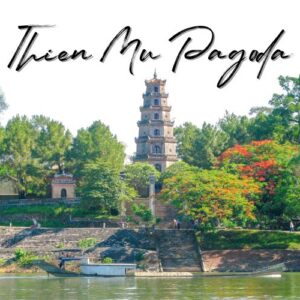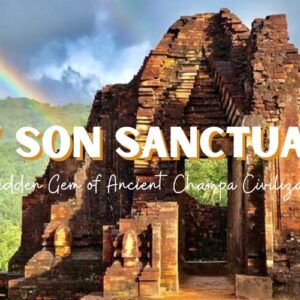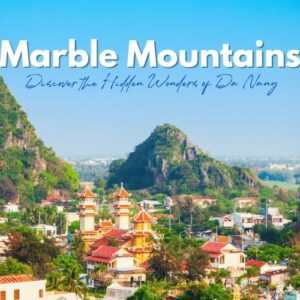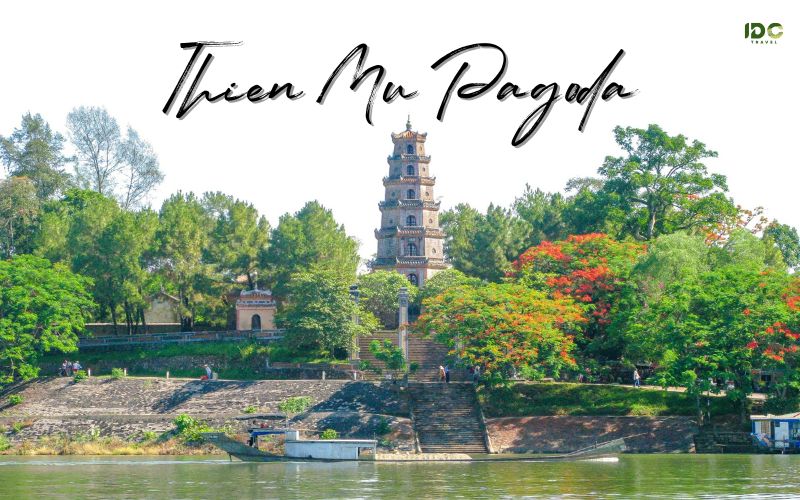
Hue, the land of the poetic and peaceful ancient capital, where the national cultural and historical values are preserved. Right in the heart of Hue city, Thien Mu Pagoda stands as a spiritual symbol, which is closely associated with the ups and downs of Hue. With its perfect location on the banks of the Huong River, the pagoda is not a popular tourist destination but a place to find tranquillity and peace.
General information about Thien Mu Pagoda
Location: Thien Mu Pagoda is located on Ha Khue Hill, An Ninh Thuong Village, Kim Long Ward, Hue City, Thua Thien Hue Province.
Opening hours: Thien Mu Pagoda is open all day, regardless of weekdays or weekends. Visitors can come here at any time; however, if you want to take pictures and enjoy the tranquil and sacred atmosphere, early morning (6:00 am – 8:00 am) is the best time. If you want to admire the sunset over the Huong River, it is recommended to be there from 5:00 pm to 6:00 pm.
Entrance fee: Free
Overview of Thien Mu Pagoda
History of Thien Mu Pagoda
On the green hill of Ha Khe, where the Huong River winds its way quietly into the heart of dreamy Hue, Thien Mu Pagoda appears like an ancient mark in the midst of tranquil nature. The pagoda is not only a religious landmark but also a legend that originated from a sacred historical dream. In 1601, when Lord Nguyen Hoang, the first lord of the Nguyen Dynasty, had just set foot in Thuan Hoa town, he wandered by himself around the region to find the sacred land in order to build a profound fortune for the next generations. One day, when he stopped on Ha Khe Hill, local people told him about a fascinating legend about an old woman who often appeared on this hill, wearing a cloth coat, grey hair like a cloud, and looking far away. She prophesied that one day, a true lord would come and build on this hill a large pagoda to gather the spirit of heaven and earth and protect the country. Then, she turned into a hazy smoke and disappeared.
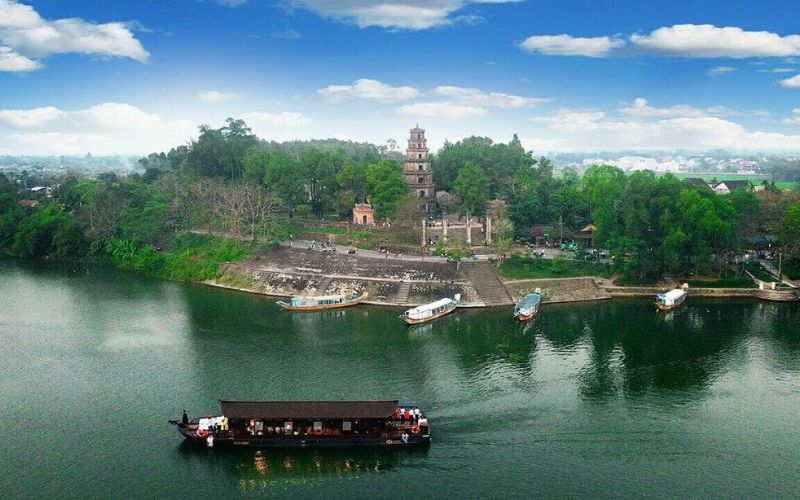
Thien Mu Pagoda on the bank of the Huong River
The story seemed to sow a strong hunch in the lord’s heart. Immediately after that, he ordered the construction of the pagoda, taking the name Thien Mu – meaning “old woman of heaven” – in memory of the legendary human god who had auspicious dreams. Since that moment, Thien Mu Pagoda has not only been a place of belief for the people of the land of nerves but also a witness to many challenges in the history of the nation.
Over four hundred years, from the time of the Nguyen lords, through the prosperous Nguyen Dynasty, to the turbulent years of the country, the pagoda still stands firmly on the banks of the Huong River as an immortal symbol of Hue culture. Every moonlit season, the temple bells ring in the middle of space, as if echoing the words of the old woman, a sacred message from the sky, blending into the thousand-year breath of the ancient capital.
Architecture of Thien Mu Pagoda
The architecture of Thien Mu Pagoda bears the imprint of Vietnamese religious art. The most outstanding feature is Phuoc Duyen Tower, which was built in 1844 under the rule of King Thieu Tri. The tower is shaped like an octagon, is 21 metres high, and has 7 floors, and each of them worships a Buddha. In front of the tower is the Huong Nguyen Communal House; the two sides have two beer houses, and in front of the communal house are two flower pillars, creating a harmonious and majestic whole. In addition, the pagoda also owns the common Dai Hong, weighing nearly 2,000 kg, minted in 1710 under Lord Nguyen Phuc Chu, showing the brilliant development of Dang Trong (Outer Land) Buddhism at that time. The works in the pagoda are arranged in a balanced manner, combined with the natural landscape, creating a pure and dignified space, attracting tourists from all over the world to worship and enjoy.

Thien Mu Pagoda architecture
What to see in Thien Mu Pagoda
Turning the back against the gently sloping Ha Khe hill and facing the slowly flowing Huong River, Thien Mu Pagoda appears like a watercolour painting in the heart of the ancient capital. Over the past four centuries, the pagoda has not only been a sacred religious site but also a symbol of Hue culture, spirit, and architecture. To have your best time here, let’s slow down and admire these highlights of Thien Mu Pagoda.
Tam Quan Gate
The first step into Thien Mu Pagoda is to pass through the ancient Tam Quan Gate, which opens up not only a temple yard but also a space imbued with the colour of Zen. The gate has three entrances, symbolising the three doors of liberation in Buddhism: the human, the devil, and the god. The Tam Quan Gate, with its moss-covered tiled roof, rustic yet delicate carvings, and the deep red colour of ironwood, evokes a sense of the past, drawing travellers away from the bustle of the world and into a peaceful place within.
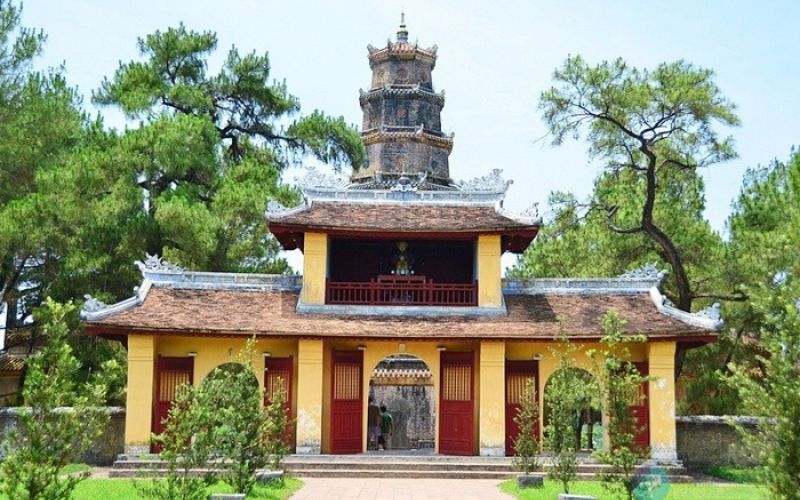
Tam Quan Gate
Phuoc Duyen Tower
In the middle of the temple stands the Phuoc Duyen Tower, which is symbolic of Thien Mu Pagoda in particular and of Hue in general. This tower was built during the reign of King Thieu Tri, with an octagonal shape of seven floors, each floor worshipping a different Buddha. The dark red brick colour of the tower stands out against the blue sky and the winding Huong River in the distance, creating a quiet and poetic image. From a distance, the tower is like a pen in the sky, recording the poems between heaven and earth. At the foot of the tower, the low fragrance is gently emitted, while at the top, when the wind blows, the wind chimes softly ring like the whispers of time from the last century.

Phuoc Duyen Tower
Dai Hung Palace
Going deep inside the pagoda grounds, visitors will reach the heart of Thien Mu Pagoda, where Buddha Sakyamuni and two Bodhisattvas, Majunshri and Samantabhadra, are worshipped. The temple is spacious, with a curved roof and a solemn yet unpretentious interior, giving the place a beauty that is both solemn and intimate. In the space filled with the scent of agarwood, the light from the candle reflects on the Buddhist statue, creating a gentle light, like the light of compassion shining into people’s hearts. This is where many Buddhists come to meditate, burn incense, and pray for peace and goodness.
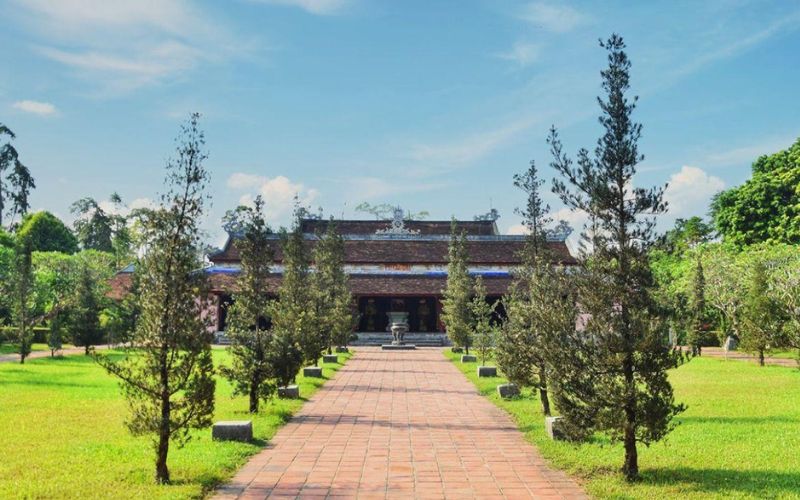
Dai Hung Palace
The Great Bell
Inside the pagoda, visitors will admire the Great Bell, one of the most precious treasures of Thien Mu. The bronze bell weighs nearly 2,000 kg, cast in 1710 under the reign of Lord Nguyen Phuc Chu. Legend has it that every time the bell rings, the sound can travel dozens of miles, echo across the Huong River, and resonate in people’s hearts like a call from the deep. Not only is it a work of artistic and technical value, but the Great Bell is also a symbol of the enduring vitality of Buddhism in the sacred land, a voice of compassion, of awakening amid an impermanent life.
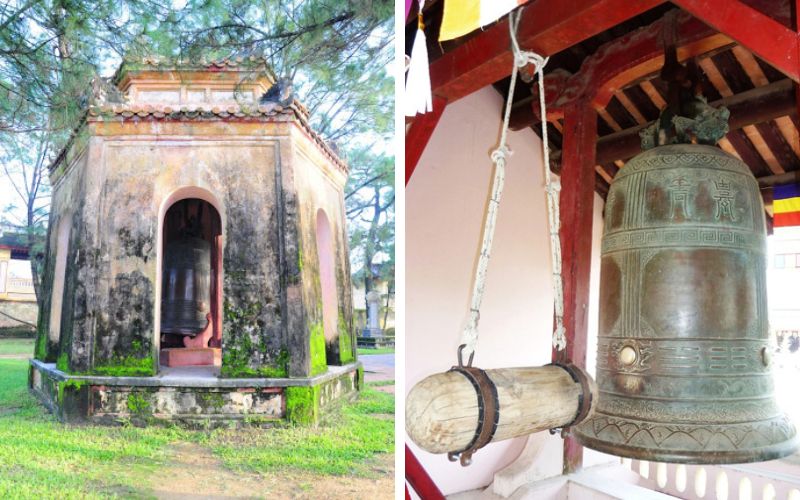
The Great Bell
The stele titled “Ngu kien Thien Mu tu”
Near the main temple is an ancient stone table titled “Ngu kien Thien Mu tu”, referring to the restoration of Thien Mu pagoda by Lord Nguyen Phu Chu in 1715. The inscription was elaborately carved on a large stone slab, recording the process of restoration and development of the pagoda as well as the support of Buddhism by the Nguyen Lords. This is not only a valuable historical document but also a living testament to the close connection between religion and life, between the royal court and spirituality in the flow of Vietnamese culture. Standing in front of the moss-covered stele, reading each line of Chinese characters that is still sharp, one seems to hear the whisper of the past echoing back, imbued with layers of sediments of the time and belief.
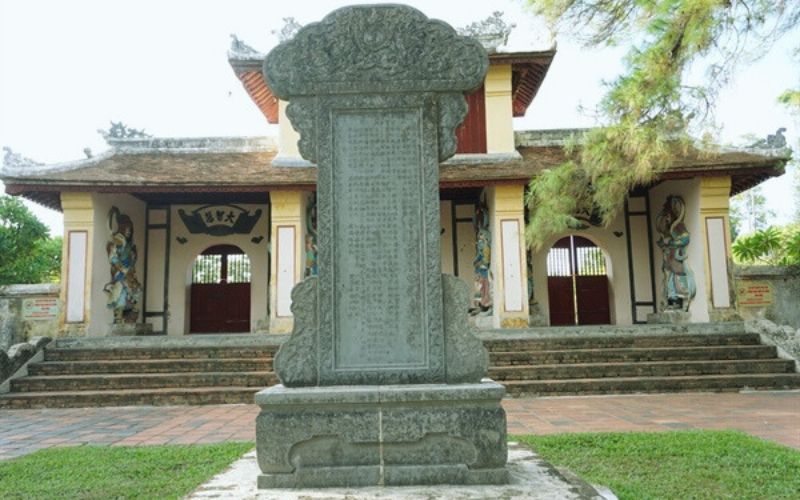
The stone tablet written by Thich Dai San
>>> Visit our Cultural Exploration of Hue in 3 Days to gain a more well-rounded perspective about Hue’s rich cultural heritage.
Some helpful tips for tourists
How to get there?
Located only about 5 km from the centre of Hue city, getting to Thien Mu Pagoda is quite easy. There are several transportation options you can opt for:
- Motorbike: This is the most convenient way to travel around Hue since you can enjoy the surroundings and breathe the fresh air. You can rent a motorbike and travel by yourself. The cost for a day rental is about 100,000 – 150,000 VND (~4 – 6 USD). To get to Thien Mu Pagoda, please follow the route: Start from Hue Imperial City, and go along Kim Long Street. From there, go straight about 2 km, and you will reach Thien Mu Pagoda.
- Bicycle: Cycling is a fascinating option because you can slowly enjoy the way to Thien Mu Pagoda. We recommend cycling in the early morning to avoid the midday heat.
- Cyclo: This is a great way to get to Thien Mu Pagoda while learning about the interesting information about Hue from the local people, who ride the cyclo. They are the ones who know the best about the city. The cost for a cyclo trip is from 40,000 to 100,000 VND/trip, depending on the length of the trip.
- Taxi: If you travel with a group of friends or family, a taxi is the best choice. There are several car agents, such as Grab, Xanh SM… You can book the car on the apps; this is so convenient.
- Boat: You can take a dragon boat to Thien Mu Pagoda for a more enjoyable and relaxing trip. It takes about 30 minutes to get to the pagoda by boat. On the way, you can enjoy the poetic scenery and feel the cool breeze on the banks of the Huong River.
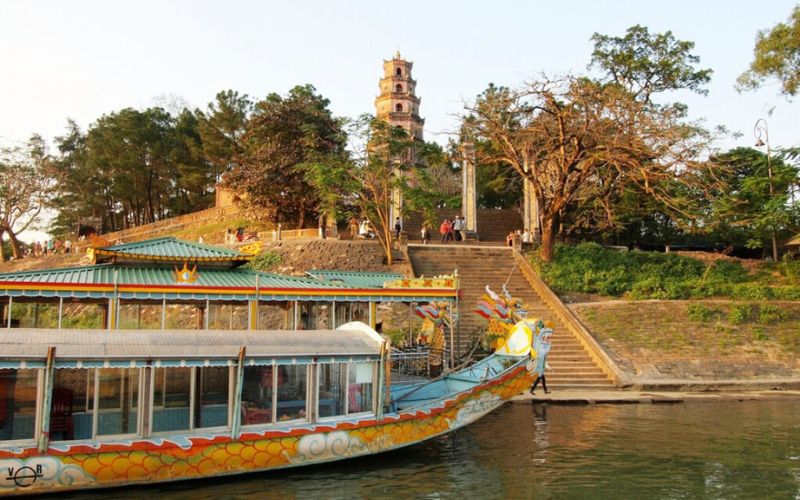
Getting to Thien Mu Pagoda by dragon boat
When is the best time to visit Thien Mu Pagoda?
Based on the travel experience of many tourists, the best time to visit Hue in general and Thien Mu Pagoda in particular is during the spring months, from February to April. During this time of the year, the weather is pleasantly cool and dry, with average temperatures ranging from 20 to 27°C. Visitors will have a chance to admire the lush green gardens and trees during the spring.
What to wear when visiting Thien Mu Pagoda?
Because Thien Mu Pagoda is a historical and religious site, visitors should wear polite and discreet clothes to show respect. When entering inside to pray, remember to take off your shoes and hat. Since the pagoda is large, visitors should bring an umbrella and water to protect their skin from the sun and stay hydrated.
Nearby attractions
Hue Imperial City
Only 5 km from Thien Mu Pagoda, Hue Imperial City was the headquarters of the Nguyen Dynasty for over 140 years. This is a large complex of palaces, towers, pavilions, and lakes, combining the sacred and majestic atmosphere. Strolling around Hue Imperial City feels like tracing back to the past and appreciating the ancient royal culture through every architectural detail and the quiet and solemn atmosphere.

Hue Imperial City
Tomb of Tu Duc
If you love the poetic and the gentle, the tomb of Tu Duc is an unmissable destination. This is the resting place of King Tu Duc, the famous poet king. Unlike other tombs, this tomb is a charming landscape painting, in harmony between nature and architecture, with a lake, pine forest, and mossy ancient roofs, creating both a solemn and poetic atmosphere.
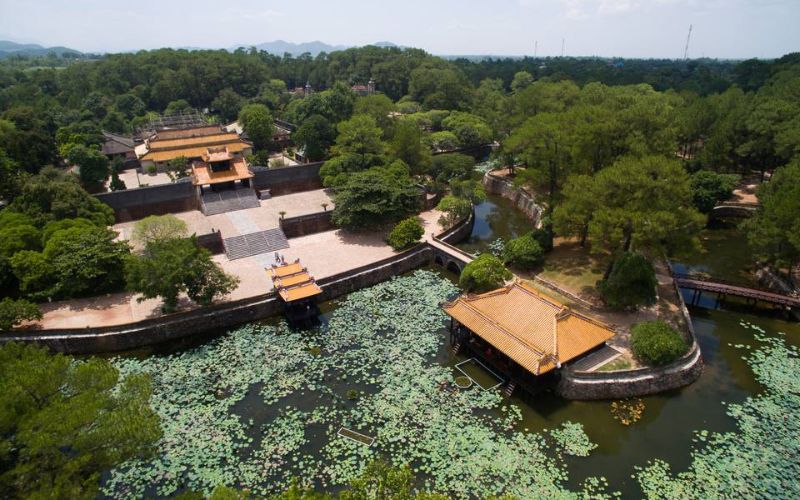
Tu Duc Tomb located in the middle of lush green trees and lakes
Thuy Xuan Incense Village
On the way from Thien Mu Pagoda to the city centre, you will pass by Thuy Xuan Scent Village, which is famous for making traditional incense. Colourful bundles of incense are dried in long rows, looking as bright as a vivid picture. Visiting the village, you can watch the locals make incense by hand. You can even try to make some incense sticks and bring them home as souvenirs.
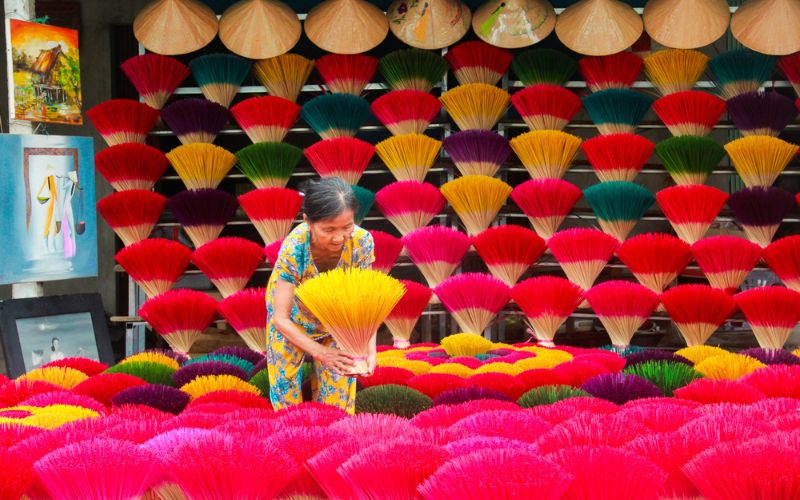
Thuy Xuan incense village
Vong Canh Hill
It takes only a 15-minute drive from Thien Mu Pagoda to get to this ideal sightseeing spot. From the top of Vong Canh Hill, you can enjoy the panoramic view of the gentle winding Huong River and ancient tombs hidden under the green canopy. Especially in the early morning or at sunset, it is the most poetic and romantic place for photography.

Scenic view from Vong Canh Hill
In conclusion, Thien Mu Pagoda is not only a spiritual symbol of Hue but also a place that preserves the solemn and sacred beauty of the ancient capital. If you have a chance in Hue, please take some time to visit this stunning pagoda, stroll around, listen to the bell ring, and feel the peace in every moment. If you need further information or assistance, please contact us; our experts are willing to help at any time!
Read more:
